 Today I am delighted to feature Henrietta Heald's Magnificent Women and their Revolutionary Machines. This is the lost story of Britain's trailblazing, boundary- breaking women engineers. To whet your appetite, I have an extract for you and also the chance to win a print copy (UK only). Details on how to enter the giveaway are at the foot of this post.
Today I am delighted to feature Henrietta Heald's Magnificent Women and their Revolutionary Machines. This is the lost story of Britain's trailblazing, boundary- breaking women engineers. To whet your appetite, I have an extract for you and also the chance to win a print copy (UK only). Details on how to enter the giveaway are at the foot of this post.
‘Women have won their political independence. Now is the
time for them to achieve their economic freedom too.’
This was the great rallying cry of the pioneers who, in
1919, created the Women’s Engineering Society. Spearheaded by Katharine and
Rachel Parsons, a powerful mother and daughter duo, and Caroline Haslett, whose
mission was to liberate women from domestic drudgery, it was the world’s first
professional organisation dedicated to the campaign for women’s rights.
Magnificent Women and their Revolutionary Machines tells the
stories of the women at the heart of this group – from their success in fanning
the flames of a social revolution to their significant achievements in
engineering and technology. It centres on the parallel but contrasting lives of
the two main protagonists, Rachel Parsons and Caroline Haslett – one born to
privilege and riches whose life ended in dramatic tragedy; the other who rose
from humble roots to become the leading professional woman of her age and
mistress of the thrilling new power of the twentieth century: electricity.
In this fascinating book, acclaimed biographer Henrietta
Heald also illuminates the era in which the society was founded. From the
moment when women in Britain were allowed to vote for the first time, and to
stand for Parliament, she charts the changing attitudes to women’s rights both
in society and in the workplace.
Extract
2. A Brilliant
Inheritance
The Parsons family’s immersion in engineering and invention
had its roots in an ancient settlement in the geographical centre of
Ireland. So closely was Parsons history
woven into Birr and its romantic medieval castle that, by 1885, when Rachel was
born, the place had been known for 365 years as Parsonstown. Its name came from
the activities and influences of two Parsons brothers who had migrated from
East Anglia to Ireland in late Tudor times, acquiring land and titles, which
they passed on to generations of descendants. From this inheritance would
eventually derive the earldom of Rosse.
Parsonstown’s prominent status in King’s County (now County
Offaly) indicated a longstanding allegiance to the English Crown, but Rachel’s
great-grandfather Laurence, a politician, had broken with tradition by his
trenchant opposition to the proposed union between Great Britain and Ireland.
Described by the Irish republican leader Wolfe Tone as ‘one of the very, very few
honest men in the Irish House of Commons’, Laurence, who favoured complete
independence for Ireland, had resigned from politics in protest when the Acts
of Union became law in 1800. That year also saw the birth of his son William,
the future engineer and astronomer who would one day bring worldwide fame to
the name of Parsons.
By the time William Parsons inherited Birr and the earldom
of Rosse from his father in 1841, he was already well on the way to
transforming human understanding of the stars. Two years earlier, Thomas Romney
Robinson, the director of the Armagh Observatory, had visited Birr to inspect
an extraordinary telescope
that had been erected in the castle grounds. Called a
Newtonian reflector, and based on a design by John Herschel, the instrument
included a three-foot-diameter speculum, or mirror, and had been built to
observe objects farther out into space and more clearly than had ever been
possible before.
Robinson stayed at Birr for more than a week, trying out the
new telescope with the help of another prominent astronomer, the Englishman
James South. The two men were amazed by what they saw. Star clusters, nebulae,
double stars – all stood out magnificently, and a host of new objects were
identified on the surface of the moon. ‘It is scarcely possible to preserve the
necessary sobriety of language in speaking of the moon’s appearance with this
instrument,’ wrote Robinson. Indeed, the Earl of Rosse would later draw on
these observations in his contribution to the development of lunar mapping.
But, as far as the noble inventor was concerned, the three-footer was only the
start. He had already conceived of the idea to build at Birr a telescope far
surpassing any of its predecessors – an instrument with a six-foot-diameter
speculum that would acquire notoriety as
the Leviathan of Parsonstown.
Construction of the Leviathan, which took almost two years
and entailed many setbacks, was an astonishing feat. Casting the speculum
required a huge foundry – created in the dry moat surrounding the castle – in
which peat-fired furnaces were used to heat three iron crucibles, each twenty-four inches in
diameter and containing 1.5 tons of a tin and copper alloy. The molten metal
was transferred by means of cranes into an enormous mould, where it was
carefully cooled over a period of sixteen weeks.
Thomas Romney Robinson was present on one occasion when the
crucibles were lowered into the furnaces. ‘The sublime beauty can never be
forgotten by those who were present,’ he wrote. ‘Above, the sky, crowded with
stars and illuminated by a most brilliant moon, seemed to look down
auspiciously on the work. Below, the furnaces poured out huge columns of nearly
monochromatic yellow flame, and the ignited crucibles during their passage
through the air were fountains of red light.’
The next stage was the laborious and time-consuming process
of grinding and polishing. ‘The speculum was successfully cast, but the surface
was covered with minute fissures, about the breadth of a horse hair,’ explained
William Rosse later in a paper to the Royal Society. ‘These we resolved to
grind out.’ The grinding continued for nearly two months, the machinery working
for part of the time at night. The speculum was then polished, and its
performance equalled expectations.
The telescope’s fifty-six-foot-long wooden tube and hoist
were fixed between two castellated brick walls fifty feet high and seventy feet
long. Movement of the tube was controlled by chains, pulleys and
counterweights. A platform for observing objects at low altitude was built at
the southern end of the walls. For high altitudes, a long gallery mounted on
the west wall moved across the central space to follow the tube’s lateral
motion. At least three assistants were needed to help the observer by moving
the winch and shifting the galley.
It had long been recognised by astronomers that the larger a
telescope’s mirror, the more light could be ‘grasped’, or collected, allowing
fainter and more distant objects to be studied – and what made the Leviathan so
powerful was its tremendous light-grasp. At the time of its creation in the
1840s, it was by far the most sub- stantial telescope ever built, and it would
remain the largest telescope in the world for almost three-quarters of a
century, until it was over- taken in 1917 by the one-hundred-inch Hooker
telescope on Mount Wilson in California.
About the Author
Henrietta Heald is the author of William Armstrong, Magician
of the North which was shortlisted for the H. W. Fisher Best First Biography
Prize and the Portico Prize for non-fiction.
She was chief editor of Chronicle of Britain and Ireland and
Reader’s Digest Illustrated Guide to Britain’s Coast. Her other books include
Coastal Living, La Vie est Belle, and a National Trust guide to Cragside,
Northumberland.
You can follow Henrietta here: Twitter | Website
Thanks to the author for a place on the tour.
Check out these other great bloggers
Giveaway ( UK only)
To win a print copy of Magnificent Women and their Revolutionary Machines, just Follow and Retweet the pinned Tweet at @bookslifethings.
Closing Date October 1st 2019
and there is one winner.
*Terms and Conditions –UK entries only. The winner will be selected at
random via Tweetdraw from all valid entries and will be notified by Twitter
and/or email. If no response is received within 7 days then I reserve the right
to select an alternative winner. Open to all entrants aged 18 or over. Any personal data given as part of the
competition entry is used for this purpose only and will not be shared with
third parties, with the exception of the winners’ information. This will passed
to the giveaway organiser and used only for fulfilment of the prize. I am not
responsible for despatch or delivery of the prize.










Oh what a great book, as a woman who became a scientist when "women didn't", the daughter of a woman who became a scientist when "women REALLY didn't", mother to a daughter who became an engineer and grandmother to a 10 year old who wants to become an engineer, I'd love to read more about the women who fought to lay the groundwork for four generations of my family to be able to follow our passions. Have retweeted @janesgrapevine
ReplyDeleteI wish you luck in the giveaway, it certainly sounds right up your street! Thanks for stopping by and reading.
DeleteThanks for the blog tour support Pam x
ReplyDelete